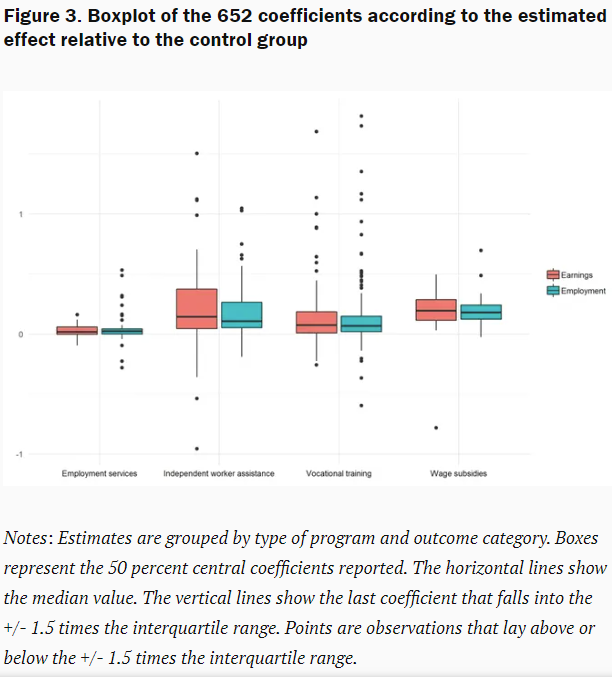Sunak& #39;s #minibudget includes a variety of active labor market policies.
There is a rich economic literature that can help inform coverage & assessments.
A short thread that points to a few recent-ish papers.
There is a rich economic literature that can help inform coverage & assessments.
A short thread that points to a few recent-ish papers.
Conceptually speaking: to minimize labor market damage in both short- and long-run policymakers need to navigate the tension between (a.) preserving valuable worker-firm relationships and (b.) facilitating reallocation in the face of temporary & structural disruptions.
On the importance of preserving match-specific capital (cf. a.), in particular, see e.g. @fpvinay with Fujita and Moscarini via @voxeu: https://voxeu.org/article/labour-market-policy-response-covid-19-must-save-aggregate-matching-capital">https://voxeu.org/article/l...
The importance of reallocation for growth and welfare is well-established, see e.g. Bartelsman, Haltiwanger, and Scarpetta (2013): https://www.aeaweb.org/articles?id=10.1257/aer.103.1.305">https://www.aeaweb.org/articles...
Vis-a-vis Covid-19, Barrero, Bloom, and Davis (2020) argue that the pandemic acts as a major reallocation shock: https://www.nber.org/papers/w27137
Notice">https://www.nber.org/papers/w2... that this is not just about between-sector reallocation, even though that facet will likely be more significant than in past recessions.
Notice">https://www.nber.org/papers/w2... that this is not just about between-sector reallocation, even though that facet will likely be more significant than in past recessions.
Also see this @voxeu piece by Pagano, Wagner, and Zechner (2020): https://voxeu.org/article/covid-19-asset-prices-and-great-reallocation">https://voxeu.org/article/c...
The Treasury& #39;s phasing out of the job retention scheme (=>limiting separation) and the introduction of active labor market policies such as hiring subsidies, training programs and job search assistance (=> promoting new matches) can be understood as a shift towards reallocation.
The furlough bonus is a bridge between JRS and promoting reallocation.
I& #39;d guess that many economists approve of the *direction* of this shift in emphasis from preservation->reallocation. Whether the *timing* is appropriate is very hard to say -- curious what #EconTwitter thinks?
I& #39;d guess that many economists approve of the *direction* of this shift in emphasis from preservation->reallocation. Whether the *timing* is appropriate is very hard to say -- curious what #EconTwitter thinks?
On the effectiveness of the various components of the package, there is a huge literature evaluating ALMPs, using empirical&theoretical tools, considering both micro (e.g. alternative program designs) and macro dimensions (e.g. large-scale hiring subsidies, demand effects, ...).
Below I mention just a *few* examples that seem immediately relevant. More broadly, in this mini-thread I gave a few more examples of how macroeconomists model unemployment: https://twitter.com/_LukasFreund_/status/1117398828070645760">https://twitter.com/_LukasFre...
As far as I understand, the micro evaluation literature points to mixed effects, with an emphasis on the significant variation across programme types and participant groups. E.g. Card, Kluve, and Weber (2018) have an influential meta-study in @JEEA_News. https://academic.oup.com/jeea/article/16/3/894/4430618">https://academic.oup.com/jeea/arti...
@eduardoyeyati, Montane and Sartorio (2020 discuss their meta-study here, with an eye towards Covid-19: https://www.brookings.edu/research/life-after-coronavirus-strengthening-labor-markets-through-active-policy/">https://www.brookings.edu/research/...
On the macro theory side, the primary message emerging from @makro_philip &Kuester& #39;s (2015) is that cyclical labor market policies are ideally targeted at insuring workers through employment, rather than subsidising unemployment. https://www.aeaweb.org/articles?id=10.1257/mac.20130028">https://www.aeaweb.org/articles...
Cahuc, Carcillo, and Le Barbanchon (2019) suggest that the French hiring credit programme implemented during the Great Recession -- unanticipated, temporary, and targeted -- had significant positive employment effects and no effects on wages. https://academic.oup.com/restud/article/86/2/593/4829925">https://academic.oup.com/restud/ar...
Addressing the Covid-recession, Merkl and Weber (2020) via @voxeu propose hiring subsidies as a cost-effective stimulus measure to reduce the risk of unemployment hysteresis effects. https://voxeu.org/article/rescuing-labour-market-times-covid-19-don-t-forget-new-hires">https://voxeu.org/article/r...
@fpvinay, Fujita, and Moscarini (2020) proposed leveraging worker age to resolve the tradeoff between protecting the valuable match-specific capital and restoring the desired pace of reallocation. https://twitter.com/fpvinay/status/1261199838244470784">https://twitter.com/fpvinay/s...
Thee age-specific programmes announced today as well as sectoral targeting seem at least broadly consistent with those principles.
Focusing more on the UK& #39;s institutional setup, various think tanks have put out interesting briefing notes, e.g. the @resfoundation here: https://www.resolutionfoundation.org/publications/getting-britain-working-safely-again/">https://www.resolutionfoundation.org/publicati...
And @EmploymtStudies here: https://www.employment-studies.co.uk/resource/getting-back-work-0">https://www.employment-studies.co.uk/resource/...
The links compiled here in a span of 10 minutes just scratch the surface, of course.
P.s.: I hereby publicly confess to having sinned twice: by procrastinating and writing this thing instead of fixing my code problem, and by breaking my own Twitter leave. But how can one, as a macro-labor person, not be fascinated by today& #39;s policy package?!

 Read on Twitter
Read on Twitter


